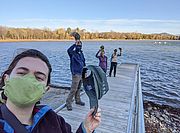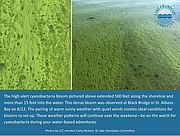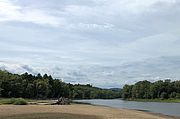Vermont is becoming warmer and wetter due to climate change. Specifically, the Vermont Climate Assessment 2021 notes that both summer and spring precipitation have increased in the Green Mountain State. The Assessment cautions that “[t]his spring precipitation . . . can make farm operations difficult.” Read...
News from Selected Category
Wetlands are vital natural resources that must be protected and restored for Vermont to address the impacts of climate change, protect wildlife habitat, restore, and maintain the quality of our waters, and provide other benefits for people and nature. In light of their significance, we believe the state of Vermont must commit to a “net gain” of wetlands. Read...
Monday, October 4th 2021
To the Vermont Climate Council,
...Significant parts of the world are literally on fire, and big portions of the rest of the nation are (or were recently) underwater. Vermont itself has recently missed being hit by not one but two massive tropical storms by mere miles, and earlier forecasts for the path of both Henri and Ida warned they might go directly through our state. And, of course, Vermonters are already experiencing more extreme heat and heavy precipitation events climate scientists have predicted for years. Read...
The state of Vermont is developing its Climate Action Plan and drafters need your input to produce a forward-thinking guidance document that addresses the climate emergency. Seven events to gain public comments will be held throughout the state beginning tomorrow and running through early October. Read...
Atlantic salmon spawning recently came to a close in Lake Champlain. Unlike their cousins in the Pacific Ocean, Atlantic salmon don’t typically die after spawning, but instead migrate back to the lake (or ocean) to feed.
Iridescent, delicious, and culturally significant, Atlantic salmon (Salmo salar) are prized in the northeast by anglers and the general public alike. Well-oxygenated, cold, deep, and fairly clear lakes, like Lake Champlain, are its primary habitat. As the seasons transition, so do salmon. In October and November, salmon move from the depths of Lake Champlain to spawn in the streams of the Lake Champlain Basin, such as the Boquet River in New York and the Winooski River in Vermont. Read...
Winter is a great time to get outdoors and it is especially helpful and healthful during the pandemic. The cold, crisp air is exhilarating and there are no biting insects! Some of the mantras for recreating safely in winter during Covid-19 are: prepare ahead, play local, physically distance from anyone not in your household, and move on after your outing so that others can enjoy the space. Below we share excerpts from guidelines for playing outdoors safely from our friends at the New York Department of Environmental Conservation (NY DEC) and Vermont Forests, Parks and Recreation (VT FPR). Read...
We weren’t sure how many people would turn out to monitor during a pandemic that required wearing a mask at public sites and quarantining for two weeks if traveling across state lines. But turn out they did! More than 160 community members signed up to check conditions at over 150 Lake Champlain and inland waterway locations during the 2020 season. They included returning veterans, first-timers, seasonal and year-round residents, couples, families, students, and friend groups. They took on more rigorous protocols, showed up virtually for training sessions via Zoom, and faithfully filed weekly reports. Read...
We send heartfelt thanks to Angela Shambaugh, our longstanding cyanobacteria monitoring program colleague who retired in October from the Vermont Department of Environmental Conservation (VT DEC). Angela has been a key partner in the monitoring program since its inception in 2003. In the early years she assisted in lab analysis, cyanobacteria assessments, water sampling, and community outreach while working at the University of Vermont. Read...
While the cyanobacteria tracker map was dominated by green dots last week, too many red dots evidencing blooms are showing as we head into Labor Day weekend. While good conditions were observed at Lake Champlain’s Malletts Bay, Main Lake South, and South Lake and at numerous inland waterways, cyanobacteria blooms showed up in Missisquoi Bay, St. Albans Bay, the Inland Sea, Main Lake North and Main Lake Central on Lake Champlain as well as at Lake Carmi, Lake Morey and Shelburne Pond. Blooms can pop up or persist well into the fall so please continue to check conditions carefully whenever recreating near waterways. Read...
Monitors filed 151 reports this week from Lake Champlain and inland lake sites. The cyanobacteria tracker map shows lots of green dots this week for generally safe conditions. However, blooms are still present in some areas of Lake Champlain and inland lakes. Read...
It’s been a tumultuous week with hot weather, intense rains that flushed nutrients and partially treated wastewater to Lake Champlain, and some high winds that knocked out power. In the midst of it all cyanobacteria monitors collectively filed 212 reports from Saturday August 8 through 1:30 p.m. on Friday August 14! Read...
The Lake Champlain Committee (LCC) and partners received 186 monitor reports last week from August 1 through 4:00 p.m. Friday August 7, 2020. Good conditions were observed in Lake Champlain’s Missisquoi Bay, Malletts Bay and the South Lake while blooms were reported for areas of St. Albans Bay, the Inland Sea, Main Lake North, Main Lake Central, and Main Lake South. Mixed conditions continued in Lake Carmi. Read...
The Lake Champlain Committee (LCC) and partners received 154 monitor reports this past week from Saturday July 25 through 1:45 p.m. Friday July 31. Good conditions were observed in Lake Champlain’s Missisquoi Bay, Main Lake North, Malletts Bay and the South Lake while blooms were reported for areas of St. Albans Bay, the Inland Sea, Main Lake Central, and Main Lake South. Mixed conditions continued in Lake Carmi this week and Lake Raponda also experienced a low alert. Read...
We received 183 monitoring reports last week through Lake Champlain Committee (LCC) Cyanobacteria Monitoring Program from Saturday July 18 through mid-afternoon Friday July 24. Due to the high volume of reports and some technical issues we weren’t able to send you the compilation until today. Read...
It’s been another busy week for the Lake Champlain Committee (LCC) Cyanobacteria Monitoring Program with 152 reports from Lake Champlain and inland lakes from Sunday July 12 through Friday July 17 at 1:30 pm! Good conditions were observed in Malletts Bay and Missisquoi Bay, there was one alert report in Main Lake Central and one in Main Lake North with mixed alert conditions in St. Albans Bay, the Inland Sea, and Main Lake South. Lake Carmi also had cyanobacteria alerts. Read...
Thank you for signing up to receive the Lake Champlain Committee’s (LCC) cyanobacteria monitoring reports! Monitoring will run through the early fall. Each week we’ll send you an update about conditions our monitors are finding around Lake Champlain and several inland lakes. This week’s report covers results from Sunday July 5 through late afternoon Saturday July 11. We had 159 reports that ranged from clear water conditions (perfect for cooling off in) to turquoise blooms that closed down access areas. Future reports will generally be sent to you on Fridays. Read...
If you’ve paddled, taken a swim, or cast a fishing line in the waterbodies of the Lake Champlain Basin, you’ve likely spent time among one of the most enigmatic groups of aquatic animals in our region: native freshwater mussels. They’re quirky—sporting hatchet-like shells and traveling by a single fleshy foot, yet familiar—related to the invasive zebra mussel and edible bivalves such as littleneck clams and scallops. Read...
Did you miss a “Zoom a Scientist” session? Don't worry! All the webinars are recorded and can be accessed via Youtube! Want to learn more about microplastics, climate change, or aquatic invasive species? Wonder how prepared we are for an oil spill or what fish do in winter? Curious about how scientists use drones and photogrammetry to learn about the lake? Read...
Vermont environmental advocates sent a letter to Governor Phil Scott on 4/6/20 thanking him for his efforts to address the unprecedented COVID-19 emergency, and urging him to uphold environmental and public health protections during the crisis, along with public accessibility and transparency.
Read...May is American Wetlands Month! Join us in celebrating our wetland wonders, from swamps and shores to floodplain forests and fens. Check out the LCC Facebook page where we’ve been posting about a different Lake Champlain watershed wetland every week. Read...
A sit spot is an outdoor site where you can go to slow down, soak up what’s around you, and appreciate nature. It is a location in your backyard or close to home—this is not a get-in-your-car activity—where you can observe changes in the natural world over time. With stay-close-to-home guidance in place, this activity can be a welcome refuge from the current uncertainty. Visit your sit spot on a timeline that works for you: daily, every other day, or weekly. We suggest returning to your sit spot at the same time of day, so you can intimately learn the patterns and rhythms of your site. Read...
Spring is a great time to recreate—blue skies, vegetation glowing green, woodland flowers bursting forth, birds in flight and song—all call us to get outside! With the recent easing of COVID-19 related restrictions on travel, we are all anxious to go further afield to exercise our bodies and lift our spirits outdoors. Please take precautions, Play Close to Home and remember that water is still deadly cold. Thank you for following these tips to help flatten the curve and keep people safe. We're in this together! Be well, everyone. Read...
Lake sturgeon can be unintentionally caught by anglers during May and June as they head upstream to spawn in the waters where they were born. The stress incurred from being hooked can inhibit their ability to reproduce. Lake sturgeon are a threatened species in New York and an endangered species in Vermont. There is no open season for lake sturgeon and possession is prohibited, so anglers should not be targeting these rare fish. Read...
Is it a bird? No. A cricket? Close! The shrill chorus of spring peepers is the chime of spring. They are among the smallest and certainly one of the most common species of frog in the Lake Champlain watershed. You can discern a spring peeper up close by a dark imperfect X pattern, contrasted against shades of brown, on its back. The “X” begets its scientific species name crucifer which means, “one who carries a cross.”
Read...Chartreuse—a luminous yellow-green color—currently punctuates wetlands and wetland edges throughout our region in the form of American false hellebore (Veratrum viride). The herbaceous perennial belongs to the lily family and is typically found in wet places such as stream corridors, moist meadows, and swamps. Mature plants can grow as tall as six feet.
Read...Conservation Biologist Steve Faccio of the Vermont Center for Ecostudies (VCE) visits a local vernal pool each week throughout the spring of 2020. In a series of seven short videos taken from April 1 through May 8 he introduces viewers to the defining characteristics of vernal pools, discusses the overwintering and breeding activities of wood frogs, and provides an underwater tour of salamander eggs, fairy shrimp, tadpoles, Caddisfly larvae, and Eastern Newts. Read...
"From Lake Champlain to the Richelieu River and the St. Lawrence, a panel of Canadian experts explores our connections and common interests in our water. Saving Our Waters is a documentary series covering steps toward keeping our waterways clean; the impacts of phosphorus and other contaminants; and using the science behind the issues to derive solutions that have positive impact on our communities." Read...
Look no further than the vast system of pipes beneath our feet—sewers—for an alternative to monitoring for viruses like COVID-19 person by person. Wastewater could provide localized data about coronavirus levels and create an early warning system for future outbreaks. In Detroit, MI, for example, an outbreak of hepatitis A was detected a week in advance of an increase in confirmed cases, by extracting the genetic material from the wastewater. Read...
Entomologist Douglas Tallamy is urging Americans “to go native and go natural” and move away from the monoculture of a lawn. He’s an advocate for native plants as a way of preserving North America’s natural ecology. His recommendations for rewilding the country include: Read...
We hope you’re healthy and finding ways to nurture yourself during these challenging times. We are looking forward to diving into the lake to refresh our spirits once temperatures warm and travel restrictions ease. In the meantime, we thought we’d share the expanded line up of “Zoom a Scientist” programs that our friends at Lake Champlain Sea Grant have put together. You can tune in virtually through Zoom every Tuesday and Friday from noon to 1:00 p.m. to learn more about the lake!
Read...


























